FOREIGN
EXPANSION AND THE SPANISH-AMERICAN WAR
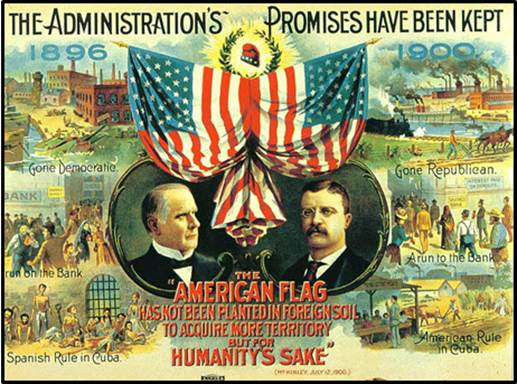
McKinley-Roosevelt Campaign
Poster: 1900
Unit Overview
American industrial growth in the late 1800s
encouraged an interest in overseas expansion and the quest for new
markets. The successful outcome of the
Spanish-American War elevated the United States to a position of global
leadership and encouraged a sense of cultural superiority. The acquisition of Hawaii, the Philippines,
Guam and Puerto Rico along with the construction of the Panama Canal reinforced
this new image. Even though there was
widespread support for these policies, some Americans saw these imperialistic
ventures as a betrayal of the nation’s democratic principles. Let’s see how it all happened.
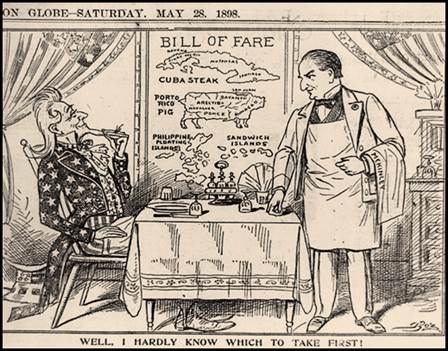
Political Cartoon from the
Boston Globe: 1898
The Path to American Imperialism
During the decades after the Civil War, the United
States became the most productive industrialized nation in the world, but it
was not regarded as a military or diplomatic leader on the world stage. Even though American manufacturing firms had
surpassed British companies with their output, Great Britain maintained an army
that was five times larger and a navy with ten times more sailors than its
American counterparts. The United States
enjoyed the luxury of being surrounded by two oceans and countries that were
usually considered non-threatening.
While European nations extended their economic, political and military
control over weaker territories through a practice known as imperialism, most Americans viewed this
policy as inconsistent with their democratic principles and had little interest
in overseas expansion.
By 1890, the attitude toward dominating regions
outside of U.S. borders had changed.
Since over one-fourth of the country’s farm products and one-half of its
oil were shipped abroad, American industrialists recognized the importance of
gaining new markets for their goods and access to raw materials. A popular theory of the era, social Darwinism, suggested that the
world’s nations were engaged in a struggle for survival and that those who
failed to compete were destined to decline.
This led some American citizens to conclude that, if the United States
did not become more aggressive in the realm of foreign affairs, the country
would be left out and left behind. This
anxiety was compounded by the nation’s population growth and the decrease in
available land for more settlers in the western part of the continental United
States.
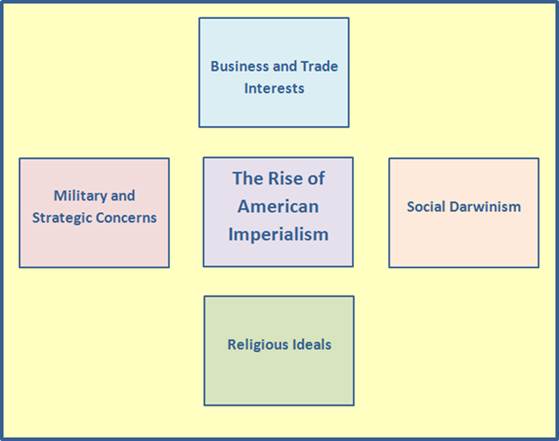
The
turn-of-the-century American public was also convinced that a powerful military
presence was an essential component of economic prosperity. The Influence of Sea Power upon History,
a popular book written by naval strategist Alfred
Thayer Mahan, stressed the importance of controlling the world’s sea
routes. His theories led the United
States, Germany and Japan to replace their wooden sailing vessels with steel
ships fired by coal or oil. If the
industrialized countries of the West were to tap into lucrative Asian markets,
naval bases and refueling stations had to be established on the islands in the
Pacific Ocean. U.S. political leaders
believed that this required a new and improved navy. To back up claims that America had become a
major sea power, President Theodore
Roosevelt ordered sixteen battleships, nicknamed the Great White Fleet, to circumnavigate the globe in 1907. A strong naval presence in the Pacific also
encouraged Americans, especially Christian missionaries, to travel to the Far
East. By 1890, over five hundred mission
centers had been established in China alone.
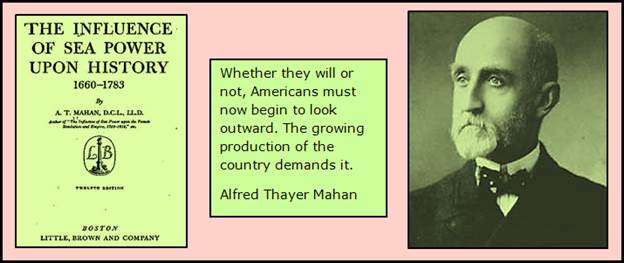
Go
to Questions 1 through 6.
The
Annexation of Hawaii
Americans and Europeans first became aware of the
Hawaiian Islands through first-hand accounts from British explorer and
cartographer Captain James Cook in
1778. Missionaries from the United
States arrived on the islands in 1820 followed by planters, who established
sugar and pineapple plantations. In a
short time, the islands’ sugar producers were selling over $20 million worth of
sugar to the United States annually, but action taken by the U.S. Congress on
behalf of domestic growers threatened this prosperous business. In 1890, the passage of the McKinley tariff
changed the American policy on the importation of sugar. This tax made it cheaper for American
households to buy sugar produced within the country. U.S. companies growing sugar cane in Hawaii
quickly realized that their profits would decline unless the islands became part
of the United States.
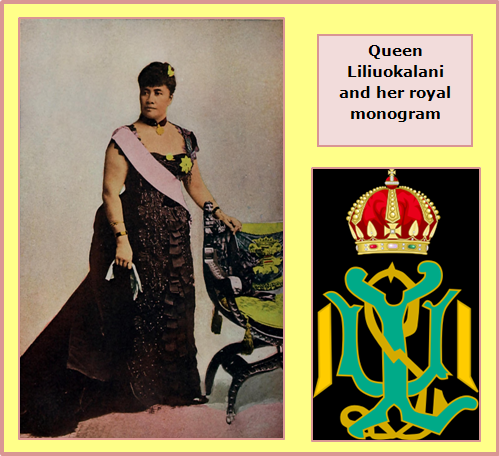
Meanwhile,
Hawaii’s ruling monarch, Queen Liliuokalani,
believed that American business interests had grown too powerful and too
influential; the Queen was determined to return control of the economy to
native Hawaiians. In response, Americans
who owned pineapple and sugar farms organized to overthrow the government with
the help of John L. Stevens, the official
U.S. representative to the Hawaiian Islands.
Backed by American soldiers, they imprisoned the Queen and seized 1.75
million acres of royal land. Liliuokalani
relinquished her throne to prevent bloodshed and called upon the United States
government to restore her authority.
When they lobbied Congress to annex Hawaii, the rebels insisted that
they had brought down a corrupt regime and advanced the principles of
democracy. In agreement, the American
military pointed out the value of Hawaii as a naval base. Although the issue was the subject of a
heated congressional debate, a joint resolution of Congress ensured the
annexation of Hawaii, and the islands became a United States territory in 1898.
Go
to Questions 7 and 8.
The
Spanish-American War
The nineteenth century saw the decline of Spain’s vast
empire that had once spanned both North and South America. As the period drew to a close, the most
important colony still under Spanish control was Cuba, and the island’s major cash crop was raw sugar. Ninety percent of that harvest was shipped to
the United States to be refined and marketed.
This put Cuba at the mercy of the U.S. economy. The cancellation of a major trade agreement
between the United States and Cuba’s colonial government set off a violent
revolution against Spanish rule in 1895.
Spain responded with a series of harsh countermeasures to put down the
rebellion. American newspapers sent
journalists to cover the story, but, since the fighting took place in the
remote regions of the island, the correspondents relied on second-hand
information and undocumented reports of Spanish atrocities. The New
York American published by William
Randolph Hearst and The New York
World, under the direction of Joseph
Pulitzer, engaged in a battle for circulation; both men printed stories to
sell papers rather than to provide accurate information to the public. This
style of reporting, which emphasized sensationalism and often ignored facts,
became known as yellow journalism.
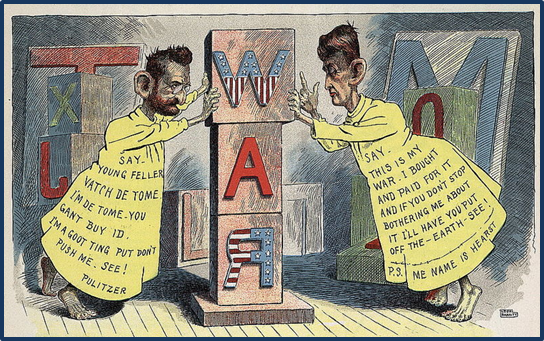
Political cartoon showing the competition between Hearst and Pulitzer
Public
opinion demanded support for the Cuban rebels, and businessmen pushed the
federal government to prevent the destruction of American-owned sugar
plantations. In response to these
demands, President McKinley ordered the U.S.S. Maine into the region to
protect U.S. lives and property. The Maine steamed into the harbor at Havana,
dropped anchor and maintained an American presence. On February 15, 1898, an explosion destroyed
the battleship and killed over 250 sailors.
A U.S. naval court of inquiry attributed the blast to a submarine mine. Although research later indicated that an
accidental fire was the root cause of the disaster, the majority of Americans
blamed Spain. President McKinley wanted
to avoid a war, but he also knew that his opposition could lead to the loss of
a second term. Spain also preferred a
peaceful settlement with the United States but would not give in on the demand
for Cuban independence. McKinley asked
Congress for a declaration of war on April 11, 1898, and Congress complied
eight days later. At the same time,
Congress also passed the Teller
Amendment which specified that the United States had no desire to take over
Cuba and was not interested in adding it to the United States as a territory.
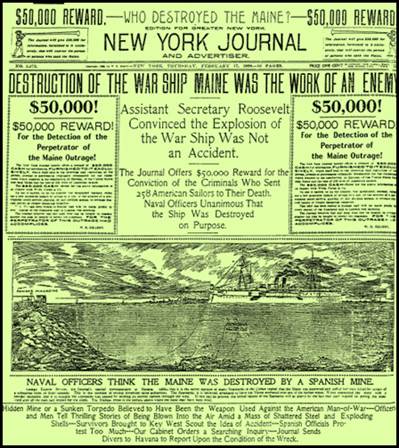
American
troops began to arrive in Santiago
in June of 1898 and fought the Spanish forces in the hills overlooking this
Cuban city. The key battle took place on
July 1 when the Rough Riders, led by
Theodore Roosevelt, took San Juan Hill.
Four African-American regiments led the frontal assault and, in spite of
heavy casualties, drove back the Spaniards.
On July 3, American naval forces destroyed the Spanish fleet anchored in
Santiago’s harbor, and this victory was followed by Spain’s surrender two weeks
later. U.S. troops also landed in Puerto Rico, the last Caribbean island
held by Spain. Spanish officials there
yielded to the Americans without a fight.
An armistice was arranged to end the conflict on August 12, 1898. Spain agreed to liberate Cuba and to cede to
the United States Puerto Rico. The
United States also gained possession of Wake and Guam, small islands located in
the Pacific. The final peace treaty
would have to wait unit the two sides settled the issues on the Spanish-American
War’s other front, the Philippines.
Go
the Questions 9 through 13.
The
Philippines
Clashes
between Spain and the United States were just not confined to the Caribbean
during the Spanish-American War. The
Philippines consisted of an archipelago of over 7000 islands and was part of
Spain’s colonial empire. The U.S. Navy
knew that part of the Spanish fleet was anchored in Manila Bay and instructed Admiral George Dewey, commander of the
Pacific fleet, to set sail for that harbor if war broke out. The Americans also arranged for Emilio Aguinaldo, who had led the fight
for Philippine liberation from Spain before his exile, to return to his home
country. Believing that the United
States supported independence for the island nation, Aguinaldo agreed to help
defeat the Spanish. On May 1, Dewey’s
squadron destroyed the Spanish ships and went on to capture the capital city of
Manila by mid-August.
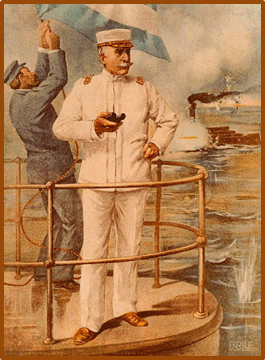
Colored print picturing Dewey at the Battle of Manila Bay
The
victory touched off an intense debate in the United States concerning the
future of the Philippines. That America
should become a colonial power in the European tradition was out of the
question. Several senators only wanted
to keep Luzon, the island on which Manila was located, and to divide the
remaining islands among the European powers.
President McKinley argued that this plan handed over valuable seaports
to other industrialized countries competing with the Americans for foreign
markets. There was also some discussion
of granting independence to the Filipinos, but this idea had little support
since most Americans believed that they were not prepared to govern
themselves. This was a major disappointment
to Emilio Aguinaldo and others who had expected self-government. They retaliated against American occupation
by the tactics of guerrilla warfare, and the U.S. Army responded by raiding
villages and carrying out indiscriminate attacks. The insurrection ended in 1902, but the
United States did not grant independence to the Philippines until 1946.
Go
to Questions 14 through 16.
The Open Door Policy
With
the acquisition of Hawaii, Guam and the Philippines, the United States had
established the stepping stones across the Pacific to the Chinese markets. By the late 1890s, China had been weakened by
internal conflicts and was unable to resist the foreign powers that wanted to
exploit her natural resources and commercial prospects. Japan, Russia, Great Britain, France and
Germany had already claimed spheres of
influence or areas in China where each nation had special privileges and
exclusive trading rights. Fearing that
American products would be shut out, Secretary of State John Hay proposed the Open Door Policy, which called for all
nations to respect the territorial integrity of China and to permit equal trade
access. He explained the idea in a
series of diplomatic notes and received only vague or evasive replies.
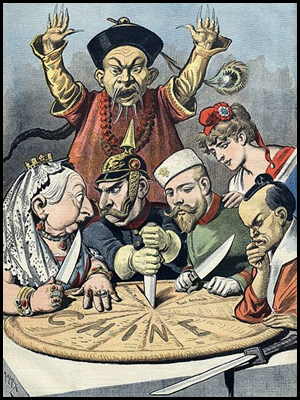
Political cartoon symbolizing
the policies of Great Britain, Germany, Russia, France and Japan
Some
Chinese were frustrated by the arrogance of those foreigners who came to China
only to further their own commercial interests.
A secret club, called the Boxers,
expressed their anti-foreign sentiments by committing random acts of
violence. This eventually led to a
full-scale revolt known as the Boxer
Rebellion. The rebels succeeded in
trapping hundreds of foreigners in the capital city of Beijing and holding them
hostage. They were rescued by a combined
military force from several nations, including the United States. The Boxer Rebellion caused Americans to fear
that Europeans might seek revenge and make their spheres of influence even more
exclusive. This would make it more
difficult to sell U.S. products in China.
With this in mind, Secretary Hay sent out a new set of notes that
stressed the importance of preserving China’s independence. Although the Open Door Policy did not turn
out to be an economic victory for the United States, it did emphasize the American
determination to increase its foreign trade and the desire to play a larger
role in world affairs.
Go
to Questions 17 and 18.
The
Panama Canal
Because
the Spanish-American War had been fought in both the Caribbean and the Pacific,
pressure to build a canal through Central America increased. The idea also appealed to U.S. industrialists
who wanted to eliminate the transportation coats generated by the long route
around South America. In 1901, President
Theodore Roosevelt opened negotiations with Columbia to lease the province of Panama for this venture.
When the Columbian legislature turned down the proposed treaty,
Roosevelt gave covert assistance to the growing independence movement in
Panama. Following a bloodless
revolution, the United States recognized the new country on November 13,
1903. Two weeks later, the United States
had a new lease on a canal zone and eventually paid Columbia $25 million to
cover its losses. The construction of
the Panama Canal is considered one
of the greatest engineering accomplishments of the twentieth century. The project involved clearing acres of swamp
land, moving 240 cubic yards of dirt and building a series of huge locks. It took the U.S. Army Corps of Engineers and
thousands of laborers eight years to complete.
When the canal officially opened in 1914, the United States had secured
a dominating strategic and commercial position in the Western Hemisphere.

Go
to Questions 19 and 20.
What’s
Next?
Even
though the United States had tried to avoid an involvement in European affairs
in the past, its emergence as a world leader now made this impossible. In 1917, American soldiers found themselves fighting
on foreign battlefields to win an Allied victory in the Great War. Although World War I would prove to be a
brutal conflict, establishing a long-term peace was another formidable
challenge. Before moving on to examine
these events, review the information in this unit; then, complete Questions 21
through 30.
Go
to Questions 21 through 30.